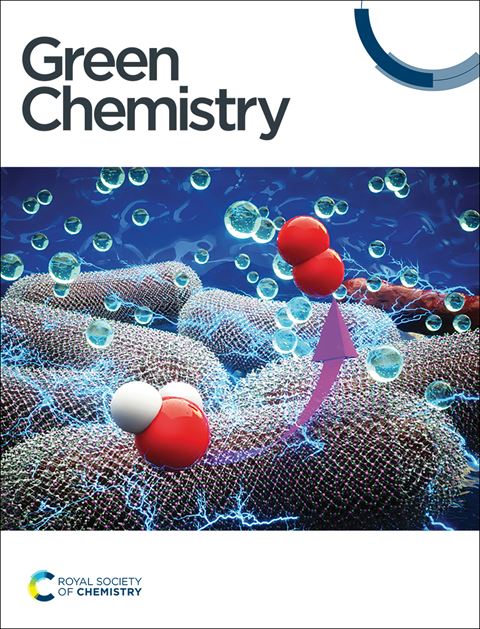分层CoNC催化剂上木质素选择性氢解制备4-丙基丁香醇的研究
IF 9.2
1区 化学
Q1 CHEMISTRY, MULTIDISCIPLINARY
引用次数: 0
摘要
通过木质素转化生产化工产品,既可以提高可再生生物质资源的利用率,又可以减少对传统化石资源的依赖。在一种新型的Co, N共掺杂碳(CoNC)催化剂的存在下,通过木质素的选择性氢解得到了4-丙基丁香醇(4-PS),这是一种高附加值的医药和材料化学品。有机溶剂蔗渣木质素在230℃条件下解聚4 h,单酚收率达28.8 wt%,产物中4- ps占34.3%,收率为9.9 wt%。广泛的表征表明,高介孔率(92.9%)和合适的孔径(>1.9 nm)分布促进了木质素在催化剂上的吸附和传质,而Co单原子与酸位(吡咯烷- n)之间的协同催化作用是CoNC具有优异催化活性的关键。木质素的结构演化、木质素模型的控制实验和DFT计算表明,木质素S单元的β-O-4键是木质素片段中活性最强的,它是4-PS具有优异选择性的原因。此外,通过电子顺磁共振(EPR)谱分析,提出了β-O-4键按碳中心自由基路径裂解的合理反应机理。因此,这项工作为生产典型的增值精细化学品提供了一种可持续的替代石油路线的策略。本文章由计算机程序翻译,如有差异,请以英文原文为准。

Selective hydrogenolysis of lignin over hierarchical CoNC catalysts for the sustainable production of 4-propylsyringol†
Production of chemicals through the conversion of lignin can not only improve the utilization of renewable biomass resources but also reduce the dependence on traditional fossil resources. In this work, 4-propylsyringol (), a high value-added chemical for medicine and materials, was obtained via selective hydrogenolysis of lignin in the presence of a novel hierarchical Co, N co-doped carbon (CoNC) catalyst. When organosolv bagasse lignin was depolymerized at 230 °C for 4 h, the yield of monophenols reached 28.8 wt%, and 34.3% of the products were (yield of 9.9 wt%). Extensive characterizations demonstrated that the high ratio of mesopores (92.9%) and the suitable pore-size (>1.9 nm) distribution of CoNC promoted the adsorption and mass transfer of lignin on the catalyst, while the synergistic catalytic effect between the Co single atom and acid site (pyrrolic–N) played a key role in the superior catalytic activity of CoNC. The structural evolution of lignin, control experiments with lignin models, and DFT calculations showed that the β-O-4 bond in the S unit of lignin was the most reactive amongst the lignin fragments, and it was responsible for the excellent selectivity of . In addition, a plausible reaction mechanism was proposed, where the β-O-4 bond cleaved according to a carbon center radical pathway, as revealed by electron paramagnetic resonance (EPR) spectroscopy results. Therefore, this work provides a sustainable alternative strategy to petroleum routes for producing typical value-added fine chemicals.
求助全文
通过发布文献求助,成功后即可免费获取论文全文。
去求助
来源期刊

Green Chemistry
化学-化学综合
CiteScore
16.10
自引率
7.10%
发文量
677
审稿时长
1.4 months
期刊介绍:
Green Chemistry is a journal that provides a unique forum for the publication of innovative research on the development of alternative green and sustainable technologies. The scope of Green Chemistry is based on the definition proposed by Anastas and Warner (Green Chemistry: Theory and Practice, P T Anastas and J C Warner, Oxford University Press, Oxford, 1998), which defines green chemistry as the utilisation of a set of principles that reduces or eliminates the use or generation of hazardous substances in the design, manufacture and application of chemical products. Green Chemistry aims to reduce the environmental impact of the chemical enterprise by developing a technology base that is inherently non-toxic to living things and the environment. The journal welcomes submissions on all aspects of research relating to this endeavor and publishes original and significant cutting-edge research that is likely to be of wide general appeal. For a work to be published, it must present a significant advance in green chemistry, including a comparison with existing methods and a demonstration of advantages over those methods.
 求助内容:
求助内容: 应助结果提醒方式:
应助结果提醒方式:


